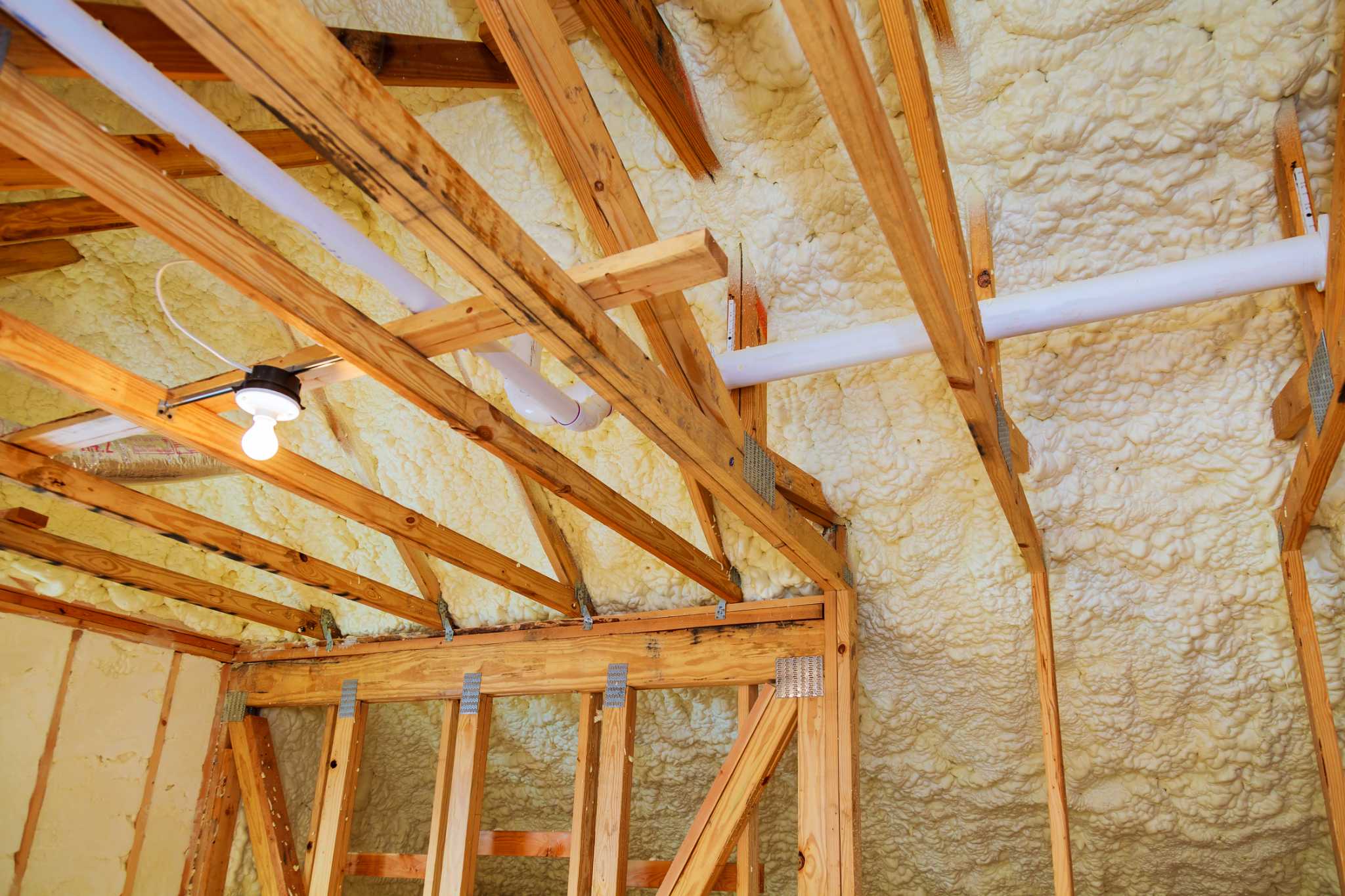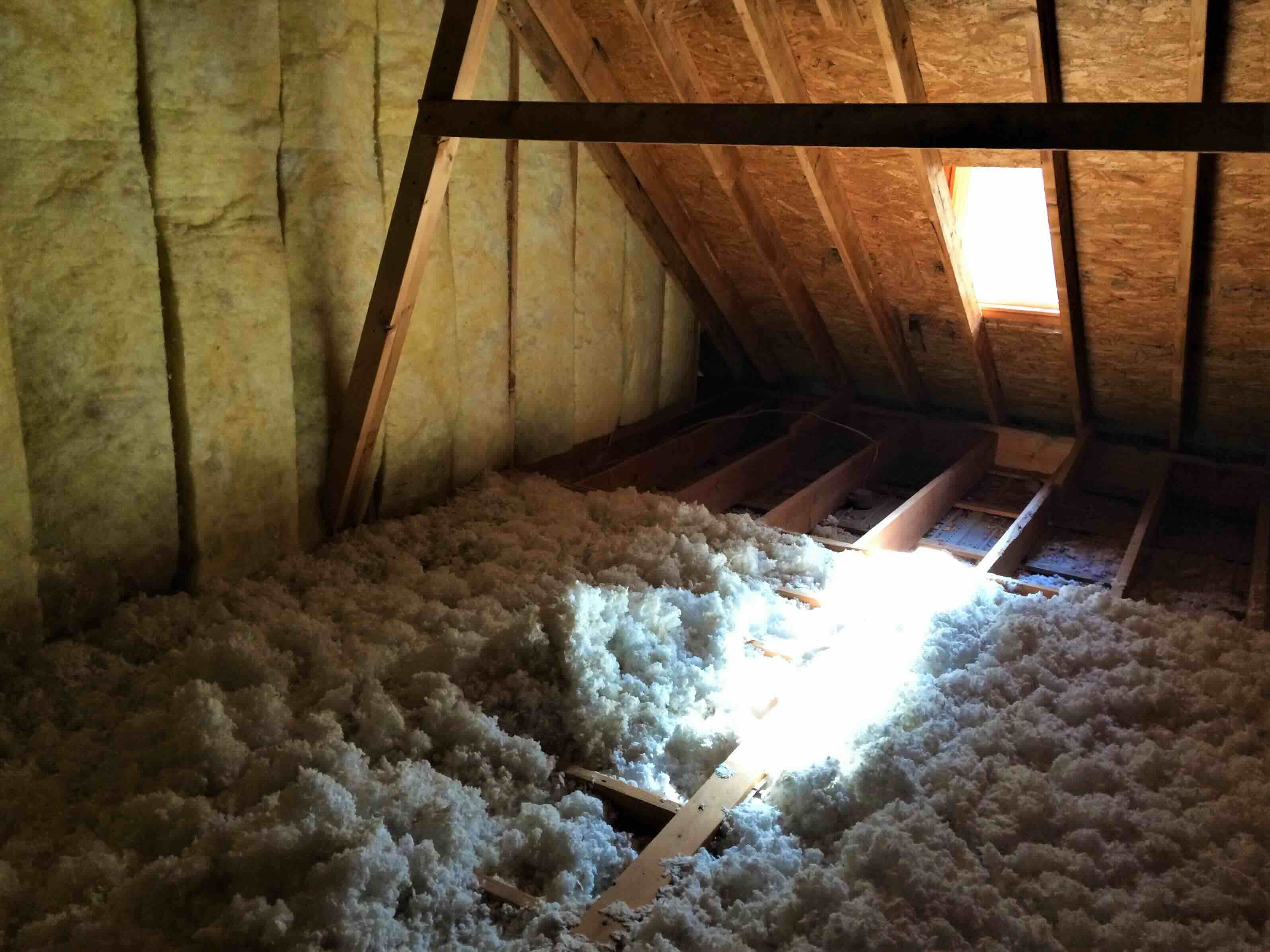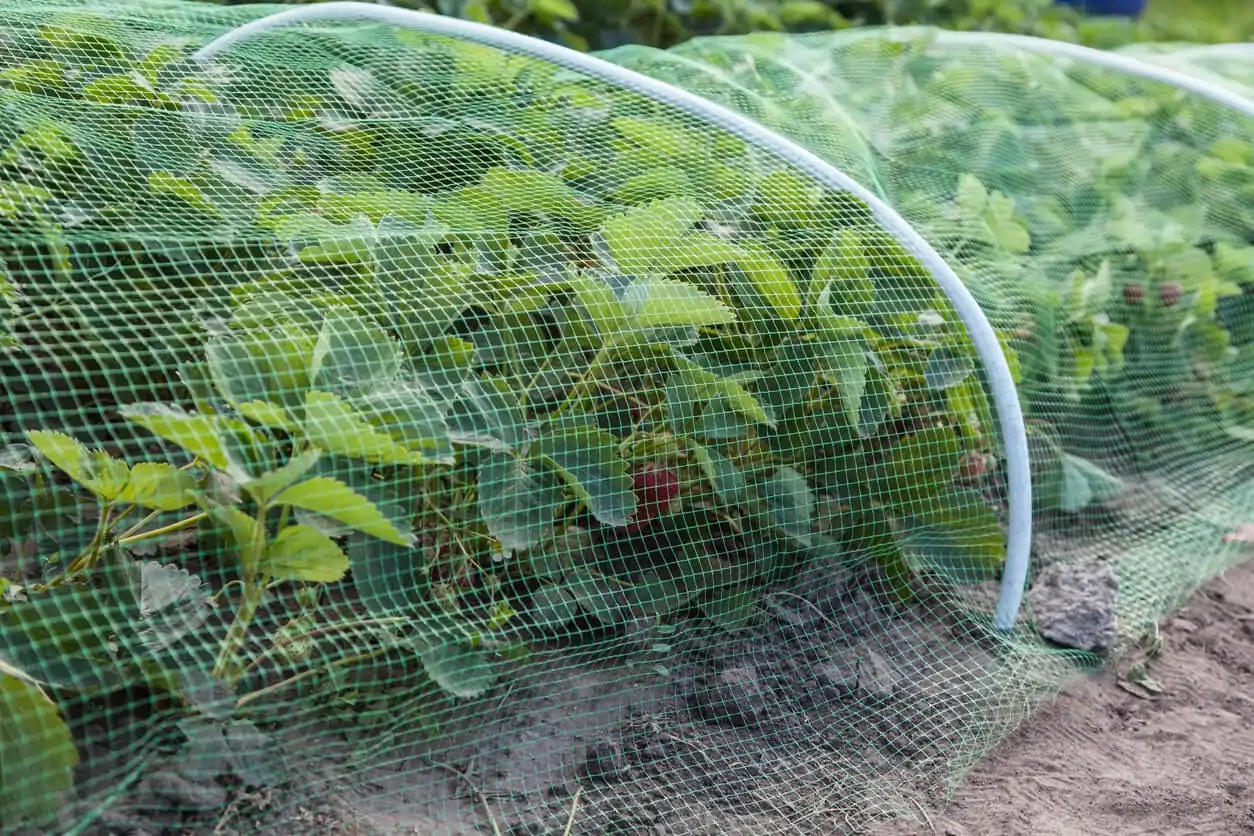

Articles
How To Keep Blown Insulation Out Of Soffit
Modified: August 17, 2024
Learn how to prevent blown insulation from entering your soffit with practical tips and articles. Keep your home protected and insulated efficiently.
(Many of the links in this article redirect to a specific reviewed product. Your purchase of these products through affiliate links helps to generate commission for Storables.com, at no extra cost. Learn more)
Introduction
Welcome to our comprehensive guide on how to keep blown insulation out of soffit. If you have a home with blown insulation, you may be familiar with the challenges of ensuring it stays in its designated areas. Blown insulation is a popular choice for homeowners due to its energy efficiency and cost-effectiveness. However, it can pose potential problems when it enters the soffit area.
Before we delve into the techniques to prevent blown insulation from entering the soffit, let’s first understand what blown insulation is and why keeping it out of the soffit is essential.
Key Takeaways:
- Preventing blown insulation from entering the soffit is crucial for maintaining proper ventilation, energy efficiency, and the structural integrity of your home. Implementing effective methods such as sealing soffit vents and installing baffles or barriers can help avoid potential issues.
- Whether you choose DIY methods or hire a professional, proactive prevention of insulation from entering the soffit is essential. Regular inspections and maintenance are necessary to ensure the long-term effectiveness of these preventative measures.
Read more: How To Calculate Blown-In Insulation
What is Blown Insulation?
Blown insulation, also known as loose-fill insulation, is a type of insulation material that is installed by blowing or pouring it into a space. It is commonly made from materials such as fiberglass, cellulose, or mineral wool, which are lightweight and have excellent insulating properties.
Blown insulation is advantageous because it can be installed in hard-to-reach areas and conforms to irregular shapes, providing better coverage than traditional batting insulation. It is often used to insulate attics, walls, and crawl spaces, helping to regulate the temperature and improve energy efficiency in homes.
When installed correctly, blown insulation creates a thermal barrier that prevents heat transfer, keeping the interior of a building warm in the winter and cool in the summer. It can help save on heating and cooling costs and improve overall comfort.
However, due to its loose nature, blown insulation can sometimes find its way into unintended areas, such as the soffit. The soffit refers to the underside of the eaves or roof overhang and is an important part of a building’s ventilation system. When insulation enters the soffit, it can obstruct airflow and cause ventilation issues, leading to moisture buildup, reduced insulation effectiveness, and potential damage to the structure.
Therefore, it is crucial to take measures to prevent blown insulation from entering the soffit area and ensure the integrity of the home’s ventilation system.
Importance of Keeping Blown Insulation Out of Soffit
The soffit plays a crucial role in the proper ventilation of a building. It allows air to flow into the attic space, preventing moisture buildup and maintaining a healthy environment. When blown insulation enters the soffit, it can obstruct airflow, leading to a range of issues that can compromise the overall functionality and integrity of the home. Let’s explore the importance of keeping blown insulation out of the soffit:
- Preventing moisture buildup: Adequate airflow through the soffit vents helps to prevent moisture from accumulating in the attic. Moisture buildup can lead to the growth of mold and mildew, which not only poses health risks but can also cause structural damage to the house. When blown insulation obstructs the soffit vents, it hinders the movement of air, increasing the likelihood of moisture-related problems.
- Promoting energy efficiency: A well-ventilated attic contributes to the overall energy efficiency of a home. Proper ventilation helps regulate the temperature, preventing excessive heat buildup in the summer and reducing the strain on the cooling systems. Insulation that enters the soffit can restrict airflow, compromising the effectiveness of ventilation and potentially leading to higher energy consumption.
- Maintaining insulation performance: Blown insulation is intended to create a barrier that prevents heat transfer and regulates the temperature inside the building. When insulation enters the soffit, it can displace or compress the insulation, reducing its overall effectiveness. This can lead to thermal bridging, where heat is able to transfer more easily between the interior and exterior of the home, resulting in higher heating and cooling costs.
- Prolonging the lifespan of the roof: Adequate ventilation through the soffit helps to minimize excessive heat and moisture in the attic, which can lead to roof damage. When blown insulation obstructs the soffit vents, heat and humidity can build up, potentially causing shingle deterioration, rotting of the roof deck, and other structural issues. By keeping blown insulation out of the soffit, you can protect the longevity of your roof.
- Avoiding potential fire hazards: Placing insulation near heat-producing fixtures, such as recessed lights or exhaust fans, can be a fire risk. When insulation enters the soffit, it may come into contact with these fixtures, increasing the potential for a fire hazard. Properly keeping insulation away from the soffit ensures that there is a safe distance between the insulation material and any potential sources of heat.
Given the importance of the soffit in maintaining proper ventilation and preserving the structural integrity of a building, it is crucial to take proactive measures to prevent blown insulation from entering this area.
Common Issues When Insulation Enters Soffit
When blown insulation enters the soffit, it can lead to a range of problems that can affect the comfort, energy efficiency, and structural integrity of a building. Let’s explore some of the common issues that can arise when insulation enters the soffit:
- Blocked airflow: Proper airflow through the soffit vents is essential for maintaining a well-ventilated attic space. When blown insulation obstructs the soffit vents, it restricts the airflow, preventing fresh air from entering and stale air from exiting the attic. This can result in poor ventilation, leading to increased moisture buildup, reduced energy efficiency, and potential mold and mildew growth.
- Reduced insulation effectiveness: Blown insulation is designed to provide efficient thermal insulation by creating a barrier that prevents heat transfer. However, when insulation enters the soffit, it can displace or compress the insulation material, reducing its overall effectiveness. This can lead to thermal bridging, where heat can easily transfer through gaps in the insulation, resulting in higher heating and cooling costs.
- Moisture problems: Proper ventilation through the soffit is crucial for preventing moisture buildup in the attic. When insulation obstructs the soffit vents, it hinders the movement of air, leading to increased humidity levels. This can cause moisture to accumulate, potentially resulting in mold and mildew growth, wood rot, and damage to the structural components of the building.
- Compromised energy efficiency: Insulation that enters the soffit can obstruct the airflow, reducing the efficiency of the ventilation system. This can result in higher energy consumption as the heating and cooling systems work harder to regulate the temperature. Additionally, the insulation may not be properly functioning in its intended areas, leading to heat or cold spots in the house and overall decreased energy efficiency.
- Potential fire hazards: Placing insulation near heat-producing fixtures, such as recessed lights or exhaust fans, can be a fire risk. When insulation enters the soffit, it may come in contact with these fixtures, increasing the potential for a fire hazard. It is important to keep insulation away from the soffit to maintain a safe distance between the insulation material and any potential heat sources.
To avoid these common issues, it is essential to take the necessary steps to prevent blown insulation from entering the soffit and ensure the integrity of the home’s ventilation system.
Tips and Techniques to Prevent Blown Insulation from Entering Soffit
To ensure that blown insulation stays in its intended areas and does not enter the soffit, there are several tips and techniques you can employ. By implementing these preventive measures, you can maintain proper ventilation, optimize energy efficiency, and avoid potential issues. Let’s explore some effective methods:
Method 1: Properly sealing soffit vents
One of the first steps in preventing blown insulation from entering the soffit is to ensure that the soffit vents are properly sealed. This involves checking for any gaps or openings in the vents and using an appropriate sealing material, such as weather-stripping or caulk, to seal off these areas. By creating a tight seal around the soffit vents, you can minimize the chances of insulation entering the space.
Method 2: Installing baffles or wind deflectors
Another effective technique is to install baffles or wind deflectors in the attic. Baffles are typically made of rigid foam or cardboard and are placed between the rafters to create a channel for airflow while preventing insulation from obstructing the soffit vents. Wind deflectors, on the other hand, are installed on the underside of the roof deck to direct the flow of air away from the soffit vents, ensuring that insulation remains in its designated area.
Method 3: Using netting or mesh barriers
Using netting or mesh barriers can be an effective way to keep blown insulation out of the soffit. These barriers can be installed over the soffit vents, serving as a physical barrier that prevents insulation from entering the area while still allowing for proper ventilation. Ensure that the netting or mesh has small enough gaps to prevent insulation particles from passing through.
Method 4: Hiring a professional insulation contractor
If you are not confident in your DIY skills or want to ensure a thorough and effective insulation installation, it may be beneficial to hire a professional insulation contractor. These experts have the knowledge and experience to properly install and maintain blown insulation without compromising the integrity of the soffit or ventilation system. They can assess your specific needs and implement appropriate techniques to ensure insulation remains where it should.
Remember, it is important to regularly inspect the soffit and attic space, especially after insulation installation or any changes to the ventilation system. This will allow you to identify any potential issues or areas where insulation may be entering the soffit and take prompt action to address them.
By following these tips and employing the various techniques mentioned above, you can effectively prevent blown insulation from entering the soffit and maintain a properly functioning ventilation system while maximizing the efficiency and longevity of your insulation.
Method 1: Properly Sealing Soffit Vents
One of the most important steps in preventing blown insulation from entering the soffit area is to ensure that the soffit vents are properly sealed. Proper sealing helps to maintain the integrity of the soffit and ensures that insulation particles do not enter the space. Here are some tips on how to effectively seal your soffit vents:
1. Inspect the soffit vents:
Start by carefully examining the soffit vents to identify any gaps, holes, or openings that may allow insulation to enter. Look for cracks, damaged caulking, or areas where the vents may have become loose or detached. Make note of any areas that need attention.
2. Clean the vent area:
Before sealing the soffit vents, it is important to clean any debris or dust that may have accumulated in the area. Use a soft brush or vacuum cleaner to remove any loose particles or obstructions. This will ensure a clean and smooth surface for applying the sealant.
3. Select an appropriate sealant:
Next, choose a suitable sealant that is compatible with the material of your soffit vents. There are various options available, such as weather-stripping, caulk, or foam sealant. Consider factors like durability, flexibility, and weather-resistance when selecting the sealant.
Read more: How To Remove Blown-in Insulation In Attic
4. Apply the sealant:
Using a caulking gun or a foam sealant applicator, carefully apply the chosen sealant around the edges of the soffit vents. Ensure that you cover any gaps or openings completely. Smooth the sealant with a putty knife or your finger to create a tight seal. Be thorough and pay close attention to detail to achieve an effective seal.
5. Allow for drying time:
After applying the sealant, allow it to dry completely according to the manufacturer’s instructions. This will ensure that the sealant forms a strong bond and creates an airtight seal. Drying times may vary, so be patient and avoid disturbing the sealed vents during this period.
6. Regularly check and maintain the seal:
Once your soffit vents are properly sealed, it is important to periodically inspect the seals for any signs of damage or deterioration. Check for any cracks, gaps, or areas where the sealant may have worn off. Address any issues immediately to maintain the integrity of the seal and prevent insulation from entering the soffit area.
Properly sealing the soffit vents is an essential step in preventing blown insulation from entering this space. By taking the time to carefully inspect, clean, and seal the vents, you can ensure that your ventilation system functions optimally while keeping insulation where it belongs.
Method 2: Installing Baffles or Wind Deflectors
Another effective technique to prevent blown insulation from entering the soffit area is to install baffles or wind deflectors in the attic. These devices create a barrier that helps redirect airflow and keep insulation in its designated areas. Here’s how you can install baffles or wind deflectors:
Read more: How Thick Is R-49 Blown In Insulation
1. Assess the attic space:
Start by assessing your attic to determine the size and layout of the area. Identify the locations where the soffit vents are located and where insulation may be at risk of entering the soffit.
2. Choose the appropriate baffles or wind deflectors:
There are various types of baffles and wind deflectors available in the market. The type you select will depend on factors such as the space available, the type of insulation, and the layout of your attic. Consider using baffles made of rigid foam or cardboard, as they provide excellent airflow and insulation protection.
3. Measure and cut the baffles:
Measure the distance between the roof trusses or rafters and cut the baffles to fit the size of the space. The baffles should extend from the soffit vents to the attic floor, allowing for proper airflow and preventing insulation from obstructing the vents.
4. Install the baffles or wind deflectors:
Place the baffles or wind deflectors between the rafters or roof trusses, ensuring that they are properly aligned with the soffit vents. Securely attach the baffles to the rafters or trusses using nails, screws, or adhesive, depending on the material you are working with. Make sure the baffles fit snugly and do not leave any gaps that insulation can pass through.
Read more: Who Does Blown-In Insulation Near Me
5. Repeat for all affected areas:
Continue installing baffles or wind deflectors in all areas where insulation is at risk of entering the soffit. Be thorough and meticulous to cover all necessary locations. Pay particular attention to areas near fixtures or ductwork where insulation might otherwise collect or interfere with the venting system.
6. Regularly inspect and maintain the baffles:
Periodically check the baffles or wind deflectors to ensure they are not damaged or displaced. Over time, insulation or other debris may accumulate around the baffles, inhibiting airflow. Clean or remove any obstructions to maintain proper ventilation and ensure the continued effectiveness of the baffles.
By installing baffles or wind deflectors in your attic, you can create a clear path for airflow and prevent blown insulation from entering the soffit. This technique helps maintain proper ventilation and ensures insulation remains in its designated areas, optimizing energy efficiency and preventing potential issues associated with insulation entering the soffit space.
Method 3: Using Netting or Mesh Barriers
Another effective method to prevent blown insulation from entering the soffit area is by using netting or mesh barriers. These barriers act as physical barriers, allowing for proper ventilation while keeping insulation in its designated space. Here’s how you can use netting or mesh barriers to protect your soffit:
1. Choose the right netting or mesh:
Select a netting or mesh material that has small enough gaps to prevent insulation particles from passing through. Look for a material that is durable, weather-resistant, and suitable for outdoor use. Options such as nylon netting or metal mesh are commonly used for this purpose.
Read more: How Long Does Blown In Insulation Last
2. Measure the size of the soffit vents:
Measure the dimensions of your soffit vents to determine the size of the netting or mesh required. It is essential to ensure that the netting or mesh adequately covers the entire vent area without leaving any gaps for insulation to enter.
3. Cut the netting or mesh to size:
Using scissors or a utility knife, carefully cut the netting or mesh according to the dimensions you measured. Take precise measurements to ensure a proper fit. Leave a bit of extra material around the edges to allow for securing the netting or mesh to the soffit vents.
4. Secure the netting or mesh over the soffit vents:
Attach the netting or mesh to the soffit vents using suitable fasteners, such as staples, zip ties, or screws. Secure the barriers tightly to ensure they do not loosen or become dislodged. Double-check that the corners and edges are securely fastened to prevent any gaps.
5. Regularly inspect and maintain the netting or mesh barriers:
Periodically inspect the netting or mesh barriers to ensure they remain intact and effectively prevent blown insulation from entering the soffit. Remove any debris or obstructions that may have accumulated on the barriers. If any damage or wear is found, promptly repair or replace the netting or mesh to maintain its effectiveness.
Read more: How Thick Is R-38 Blown Insulation
6. Consider professional installation:
If you are unsure about the installation process or have a complex soffit structure, it may be beneficial to hire a professional to install the netting or mesh barriers. They have the expertise to ensure proper coverage and effective insulation protection.
By utilizing netting or mesh barriers, you can create a physical barrier that prevents blown insulation from entering the soffit, while still allowing for proper ventilation. This technique helps to maintain the integrity of your home’s ventilation system and ensures insulation remains in its designated areas, optimizing energy efficiency and preventing potential issues associated with insulation entering the soffit space.
Method 4: Hiring a Professional Insulation Contractor
If you prefer a hassle-free and expert approach to prevent blown insulation from entering the soffit, hiring a professional insulation contractor is a highly recommended method. These professionals have the knowledge, experience, and specialized equipment to ensure a thorough and effective insulation installation while avoiding any issues with the soffit. Here’s why hiring a professional insulation contractor can be beneficial:
1. Expertise and Experience:
Insulation contractors have extensive knowledge and expertise in properly installing insulation materials. They are familiar with the best practices and techniques to prevent insulation from entering the soffit. Their experience and skill ensure that the insulation is applied correctly, maintaining the integrity of the soffit and ventilation system.
2. Proper Assessment:
Professional insulation contractors can assess your specific situation and determine the most effective methods to prevent insulation from entering the soffit. They will evaluate factors such as the type of insulation, your home’s construction, and the layout of the soffit to develop a customized plan that addresses any potential issues or vulnerabilities.
3. Quality Materials and Equipment:
Insulation contractors have access to high-quality insulation materials and specialized tools and equipment. They use industry-approved products and techniques to ensure the insulation is installed correctly and remains in its designated areas. Professional-grade materials and equipment contribute to a more effective and long-lasting insulation solution.
4. Compliance with Building Codes and Standards:
Professional insulation contractors are knowledgeable about local building codes and regulations. They ensure that the insulation installation aligns with the required standards, including proper air circulation and ventilation through the soffit. Compliance with building codes is essential for the safety, performance, and legality of your home.
5. Time and Cost Savings:
Hiring a professional insulation contractor saves you time and effort. They will handle all aspects of the insulation installation, including the prevention of blown insulation from entering the soffit. They are equipped to efficiently complete the work, allowing you to focus on other priorities. Additionally, professional installation reduces the likelihood of costly mistakes or rework associated with DIY projects.
6. Warranty and Guarantees:
Professional insulation contractors typically offer warranties or guarantees on their workmanship and the materials used. These warranties provide peace of mind and ensure that any issues arising from the installation will be addressed promptly and effectively.
When you hire a professional insulation contractor, you are entrusting the insulation installation and the prevention of insulation from entering the soffit to skilled experts. Their expertise, experience, and commitment to quality will help you achieve optimal insulation performance while protecting the integrity of the soffit and ensuring proper ventilation.
Conclusion
Keeping blown insulation out of the soffit is crucial for maintaining proper ventilation, energy efficiency, and the overall integrity of your home. Insulation entering the soffit can lead to a range of issues, including blocked airflow, reduced insulation effectiveness, moisture problems, compromised energy efficiency, and potential fire hazards.
To prevent blown insulation from entering the soffit, there are several effective methods you can employ:
- Method 1: Properly sealing soffit vents: By inspecting the vents, cleaning the area, selecting an appropriate sealant, applying the sealant properly, and regularly checking and maintaining the seals, you can prevent insulation from entering the soffit.
- Method 2: Installing baffles or wind deflectors: Placing baffles or wind deflectors in the attic creates a barrier that redirects airflow and keeps insulation away from the soffit vents.
- Method 3: Using netting or mesh barriers: Netting or mesh barriers act as physical barriers that allow ventilation while preventing blown insulation from entering the soffit.
- Method 4: Hiring a professional insulation contractor: Engaging the services of a professional insulation contractor ensures expert installation, proper assessment, compliance with building codes, and the use of quality materials and equipment.
Implementing these preventive measures will help maintain the integrity of your soffit, optimize energy efficiency, and avoid potential issues associated with insulation entering the soffit space.
Whether you choose to tackle the task yourself or hire a professional, it is essential to be proactive in preventing insulation from entering the soffit. Regular inspections and maintenance are necessary to ensure the effectiveness of the preventative methods over time.
Remember, proper ventilation and insulation go hand in hand in creating a comfortable, energy-efficient, and safe living environment. By taking the necessary steps to keep blown insulation out of the soffit, you can enjoy the benefits of well-maintained insulation and a properly functioning ventilation system in your home for years to come.
Frequently Asked Questions about How To Keep Blown Insulation Out Of Soffit
Was this page helpful?
At Storables.com, we guarantee accurate and reliable information. Our content, validated by Expert Board Contributors, is crafted following stringent Editorial Policies. We're committed to providing you with well-researched, expert-backed insights for all your informational needs.







0 thoughts on “How To Keep Blown Insulation Out Of Soffit”